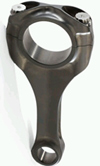Vibrations
 Any technical discussion about engine vibration generally revolves around one of two areas, namely the cranktrain and the valvetrain. In terms of the crankshaft, torsional vibrations - or rather their avoidance or mitigation - are a major concern.
Any technical discussion about engine vibration generally revolves around one of two areas, namely the cranktrain and the valvetrain. In terms of the crankshaft, torsional vibrations - or rather their avoidance or mitigation - are a major concern.
In these days of computer simulation, we can run analyses to study this phenomenon. For many years, however, engineers had to rely on formulae and a lot of painstaking calculations, as laid down in books such as "A Handbook of Torsional Vibration" by Nestorides. These calculations, which can pretty accurately predict natural frequencies and their amplitudes, are made far simpler now by the use of the ubiquitous spreadsheet.
These types of 'hand' calculations - when 'hand' literally meant writing out the formulae and working them through with a pencil and slide-rule - were a legal requirement for engine designers in certain fields, most notably where engines were designed for marine use. So a large body of literature exists on the subject, albeit probably now collecting dust on rarely visited university bookshelves.
Natural frequencies, amplitudes and stresses were calculated, and one had to prove that in use the engine either never got into the dangerous speed range concerned, or the frequency was a transient only ever encountered below cruising speed for example. These calculations had to take into account each different engine installation. Where avoiding critical speeds was not possible, boat operators had to be aware of which engine speeds or water speeds to avoid, as well as speeds that must be travelled through as quickly as possible.
Valvetrain simulation looks at the excitation of the system by the cam profile, and we aim to avoid frequencies that would see the spring resonate and surge, leading to loss of valve control.
In terms of the con rod, we also need to be aware that it has its own critical speeds, some of which may be in the operating speed of the engine. If the con rod is operated within a range close to its natural torsional frequency, the rod begins to twist back and forth.
At the point of closest approach between the valve and piston, this could cause the valve to make contact with the piston, and this is one reason why valve pockets are designed to be a reasonable amount larger than the valve. The greater volume of valve pockets leads to lower compression ratios in engines where it is difficult to achieve the desired ratio.
Depending on the level of stress, the continuous running of the engine in the region of torsional resonance of the con rod may lead to fatigue problems. Bearing problems may also occur.
As with the torsional pendulum we may have studied at school or university, where the frequency depended on the dimensions and modulus of the wire and the inertia attached to the end, the proportions of the con rod and its materials have a critical bearing on the natural frequency, as does the inertia of the piston assembly about its axis. A stiffer con rod or a lower inertia piston will tend to increase the engine speed at which the resonant frequencies occur.
Fig. 1 - It is important to avoid running constantly in resonant conditions (Courtesy of Pankl Racing Systems)
Written by Wayne Ward